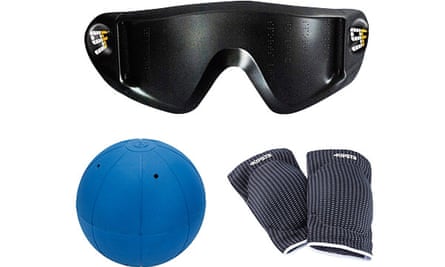The diagnosis for retinitis pigmentosa came when I was a kid. The visually impaired classification came later, when I was 18. At that age you feel invincible, but when they say, “Listen fella, your eyes are really bad and you’re going to go blind”, it hits you hard.
The Guardian’s product and service reviews are independent and are in no way influenced by any advertiser or commercial initiative. We will earn a commission from the retailer if you buy something through an affiliate link. Learn more.
I found my visual impairment very isolating and became quite reclusive. I was in a physical slump. That was before I had contact with my rehabilitation officer for the visually impaired, Greg, who pulled me out of the mire. It was he who nagged me into trying goalball. I only went to get him off my case. That was more than two years ago, and I haven’t missed a session since.
Goalball is played between two teams of three. The aim is to defend your goal while trying to score at the opposing end. The ball, which is thrown underarm, has bells in it, so it’s audible, and the court is tactile, so everybody can feel where they are at all times. There are different levels of visual impairment among players, so everyone is blindfolded, to create a level playing field.
The pace of the game is phenomenal. You’re up, you’re down, you’re spinning, sliding, running, rolling and diving around. It’s so good for fitness. Just in the last year, since I stepped up from novice to intermediate, I’ve lost three stone. Certain muscles – biceps, back and shoulders – are becoming more defined. I get a real buzz from it, and I’ve started to feel good about myself.
Off the court, too, my entire outlook and personality have changed. You turn up to tournaments and there are 40 or 50 visually impaired people there, and you realise that you are not alone. It’s almost like, “What was I moaning about? All this time I’ve lost. All the goalball I could have played!”
People who know me cannot believe the transformation. It sounds cheesy, but it’s all down to goalball.
My weekend workout
How often do you play? Tournaments are every three months, but with training, four days a week.
Proudest achievement? My first medal – gold at last year’s season finale.
Five ways to get started
1 Goalball was specifically designed for visually impaired people, but sighted people are also eligible – and encouraged – to play, all the way up to elite level. They’re only barred from international and Paralympic competitions.
2 The eye shades worn by goalball players have elasticated straps and foam on the inside and are reasonably comfortable, but wearing them can still be daunting for fully or partially sighted people. Beginners tend to wear a version of a sleeping mask to ease them into it, until they’re ready for the full blackout shades.
3 The most basic position for defending your goal is what’s known as a defensive barrier. Lie on your side with your arms and legs outstretched – you’re trying to cover as much of the 9-metre-wide goalmouth as you can.
4 Purists don’t much like the comparison, but the best way to think about the throwing technique is that it’s a bit like tenpin bowling. Take two or three strides then throw the ball underarm.
5 Clubs are located across the UK and always welcome beginners. To find your nearest, and full details of their training times, visit the Goalball UK website.
Essential kit


Comments (…)
Sign in or create your Guardian account to join the discussion